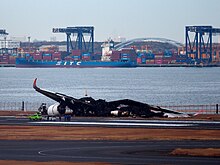Port of Tokyo
This article needs to be updated. (July 2021) |
| Port of Tokyo | |
|---|---|
tonnes (2007)[2] | |
| Annual container volume | 3,696,000 Twenty-foot equivalent units (2007)[3] |
| Value of cargo | ¥12,012.9 billion (2006)[2] |
| Website kouwan.metro.tokyo.jp/en | |
The Port of Tokyo is one of the largest
The port is also an important employer in the area having more than 30,000 employees that provide services to more than 32,000 ships every year.
History
The forerunner of the Port of Tokyo, the Edo Port
The development of the port was finally encouraged during the
The
After World War II the development of the port became a vital task for the reconstruction of the Japanese industry, and construction started on the Toyosu coal terminal, the Harumi terminal and other terminals one after another.[4]
By the late 1960s, the container transport system had become a major factor in shipping worldwide. In 1967, Nippon Container Terminals, Ltd. (NCT), became the port's (and Japan's) first container terminal operator. That same year, the first container ship to call on a Japanese port was the first such ship handled by NCT.[4] This significantly contributed to establishing the Port of Tokyo as a major international trade port.[5]
Statistics
In 2007 the Port of Tokyo handled 90,810,000 tonnes of cargo and 3,696,000 twenty-foot equivalent units, making it one of the busiest cargo ports in Japan and one of the largest container ports in the country.[2]
| Year | 2004 | 2005 | 2006 |
|---|---|---|---|
Vessels (number)
|
32,633 | 32,180 | 31,653 |
| Foreign trade (trillion ¥) | 9.9 | 10.8 | 12 |
| Containers (twenty-foot equivalents) | 3,358,000 | 3,598,000 | 3,696,000 |
| Containers* | 42,972,000 | 43,281,000 | 42,987,000 |
| Other cargo* | 48,455,000 | 48,751,000 | 47,824,000 |
| Total*' | 91,427,000 | 92,032,000 | 90,811,000 |
- * figures in tonnes
Terminals

Container terminals
The Port of Tokyo has three container terminals with an area of 1,504,718 m2 with a total number of 15
Oi container terminal
The terminal has seven
Aomi container terminal
The terminal has five
Shinagawa container terminal
The terminal has three
Kamigumi Tokyo container terminal
The terminal has one
.Foodstuff terminal
There are two
General cargo
The
Automobile terminal
The Port of Tokyo has two
Passenger Ship terminal
- Harumi Passenger Ship terminal - International passenger Ship terminal.
- Takeshiba Passenger Ship terminal - Domestic passenger Ship terminal.
- Tokyo port ferry terminal - Domestic ferry terminal.
See also
- List of East Asian ports
- Tokyo Bay
References
- ^ Port of Tokyo number of employees Archived 2009-09-28 at the Wayback Machine
- ^ a b c d Outline of the Port of Tokyo Archived 2011-08-13 at the Wayback Machine
- ^ Port of Tokyo Statistics Archived 2011-08-12 at the Wayback Machine
- ^ a b c d e f The History of the port of Tokyo Archived 2011-08-13 at the Wayback Machine
- ^ "Terminal operation". Archived from the original on 2018-06-06. Retrieved 2009-01-22.
- ^ Official figures Archived 2011-08-13 at the Wayback Machine
- ^ Shinagawa container terminal Archived 2011-08-13 at the Wayback Machine
- ^ Foreigen Trade General Cargo Terminals Archived 2011-10-02 at the Wayback Machine
- ^ RoRo Terminal Archived 2011-10-02 at the Wayback Machine
